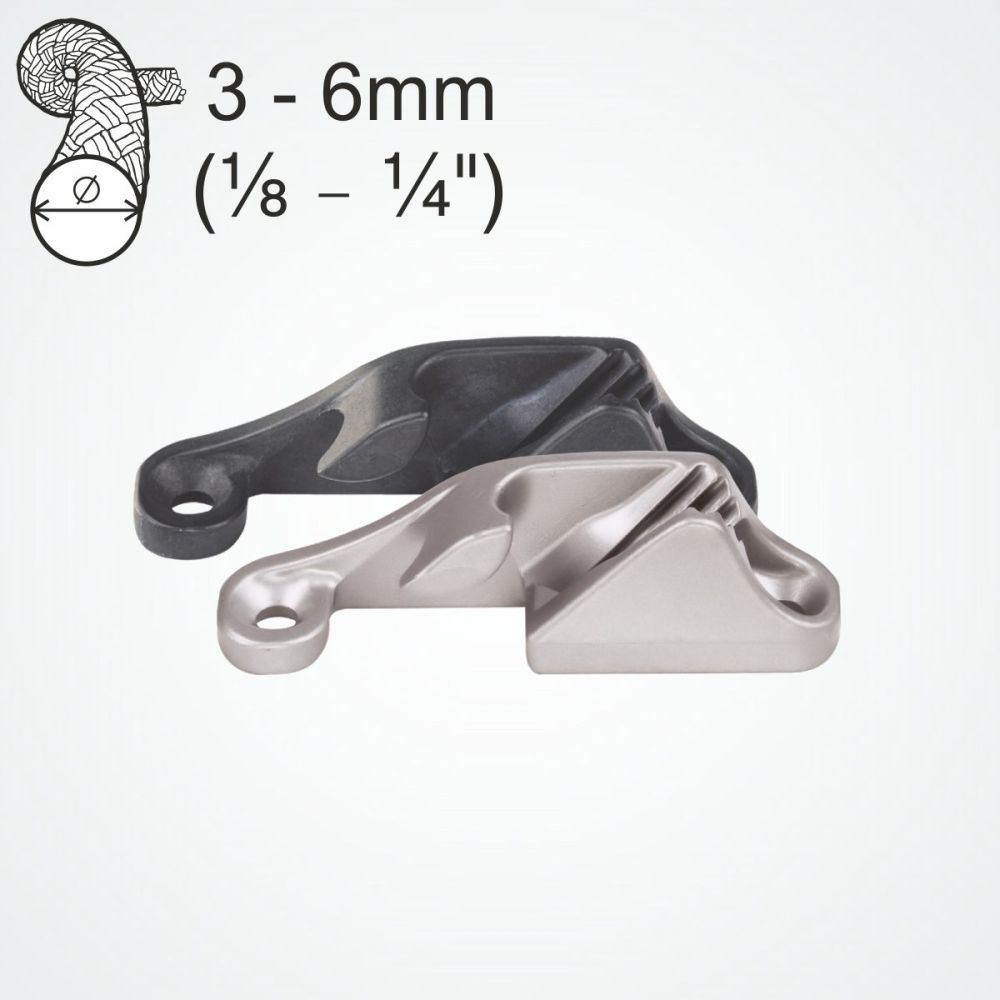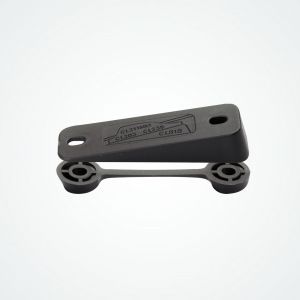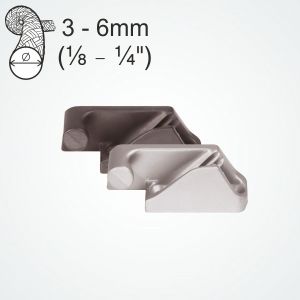clamcleat.com uses cookies to ensure we give you the best experience on our website. By navigating our site, you agree to allow us to use cookies, in accordance with our Privacy Policy

CL218 Mk1 Side Entry Mk1 (Port)
| Technical Details | Metric | Imperial | |
|---|---|---|---|
| Rope Diameter | 3 - 6mm | 1/8 - 1/4" | |
| Material | Aluminium | Aluminium | |
| Hole Centres | 66mm | 2 5/8" | |
| Length | 82mm | 3 1/4" | |
| Width | 18mm | 11/16" | |
| Height | 23mm | 7/8 | |
| Bolt Size | M5 | #10-24. 3/16" | |
| Screw Size | 4.8 | No 10 | |
| Weight | 32gms | 1.2oz |
The side entry fairlead allows ropes to be hooked in for cleating, yet easily removed. Ideal as a reaching hook. The Clamcleat® CL218 Mk1 can be fitted with a CL814 Keeper, to keep the rope in or out of the teeth - ideal when used under a spar. Using a CL818 Tapered Pad allows the CL218 Mk1 to mounted at an angle, which can aid rope alignment.
Clamcleat® CL218 Mk1 is available in two finishes:
CL218 Mk1 has a silver stove enamel finish for a cost effective, high quality coating.
CL218 Mk1AN has a hard anodised finish to give a hard wearing surface.
CL217 Mk1 is the Starboard version of this cleat.
See CL828-17 for a version of this cleat that is rigged on a rope.
CL218 Mk2 ia a smaller cleat with side-entry fairlead.
Q: What size of rope can you use on the CL218MK1?
Ans: The CL218MK1 will accept ropes from 3-6mm.
Q: What is a side entry cleat?
Ans: A side entry cleat allows the rope to be removed from the cleat from the side and placed back into the teeth easier. Ideal for use with spinnaker guy sheets where the leeward cleat is not required.
Q: What fixing do I need to secure the Clamcleat® CL218MK1 Cleat?
Ans: The fixing for a CL218MK1 cleat is M5 CSK or 4.8mm no 10 woodscrews.
Q: What are the hole centers for securing the Clamcleat® CL218MK1 Cleat?
Ans: The hole centers for the CL218MK1 cleat are 66mm 2 5/8”.
Q: Is there a tapered pad for the Clamcleat® CL218MK1 cleat?
Ans: The tapered pad for the CL218MK1 is CL818.
Q: Is there a keeper of the Clamcleat® CL218MK1 cleat?
Ans: The keeper for the CL218MK1 is CL814.
Q: Why does Clamcleat® not publish safe working loads (SWL) or break loads for its cleats?
Ans: The quality, type and style of the rope or cord plays a major role in the performance of the cleat. Normally the better the quality of the rope the greater holding power, also some cleats are designed to slip once they exceed the desired holding load as a safety feature including securing fabrics such as sunshades or covers.
Q: Do you get a better performance with an Aluminum cleat?
Ans: Aluminum cleats do not improve the performance of the cleat, but they can achieve higher holding loads and they also might improve the lifespan of the cleat especially if the rope will be in contact with the teeth whilst the rope is being pulled through during adjustment.
Q: What different coating are there for the Aluminum cleats?
Ans: The standard coating for the cleat is a Stoving Aluminum silver enamel coating. For extra protection from corrosion and a high-tech appearance the cleats are also available in a dark grey Hard anodized finish. The part no in suffixed with “AN” to identify the hard anodized finish.
Q: What is the best way to fix an aluminum cleat into a carbon fiber spar?
Ans: You need to create a barrier between the aluminum cleat and the carbon fiber surface to stop electrolytic de-composition. The barrier can be created by cutting a thin shim of plastic to the shape of the cleat and drill the fixing holes (the retail card the cleat is sold on is ideal to use as the shim), also use aa inhibitor or anti corrosive jointing compound such as Duralac on the fixing.
Q: Do you need to put a barrier between the Aluminum cleat and the stainless-steel fixing?
Ans: You need to add a inhibitor or barrier compound between the fixings, the Aluminum cleat and the mast or boom. For example, Daralac anti corrosive jointing compound.
Q: How long should an Aluminum cleat last?
Ans: This really depends on the usage, the quality and age of the rope used etc. so is very difficult to gauge. The ultraviolet rays will discolor the cleats over time and in very sunny climates may affect the life of the cleat. In extreme climates the life expectancy should be 10 -15 years depending on usage and in more moderate climate 20 + years.
Q: Can I fit my cleats using pop rivets?
Ans: Using pop rivets to fit your cleat is a tidy quick way of securing the cleat. Ensure the pop rivet is at 90 degrees to the cleat when fixing and with certain smaller cleats the head of the pop rivet gun will not sit onto the pop rivet when in place so you will require to add a spacer between the gun and the rivet.
Q: What type of rope or cord will give the best performance on my cleats?
Ans: In our experience a braided good quality rope gives you the best holding performance.
Q: What is the largest cleat Clamcleat make?
Ans: The CL220 is the largest cleat in the Clamcleat® range and is designed for a rope from 12-16mm 3/8 to 5/8”.
Q: Is there any maintenance required to a cleat to keep it performing well?
Ans: We would recommend flushing the with fresh water as often are you can.













